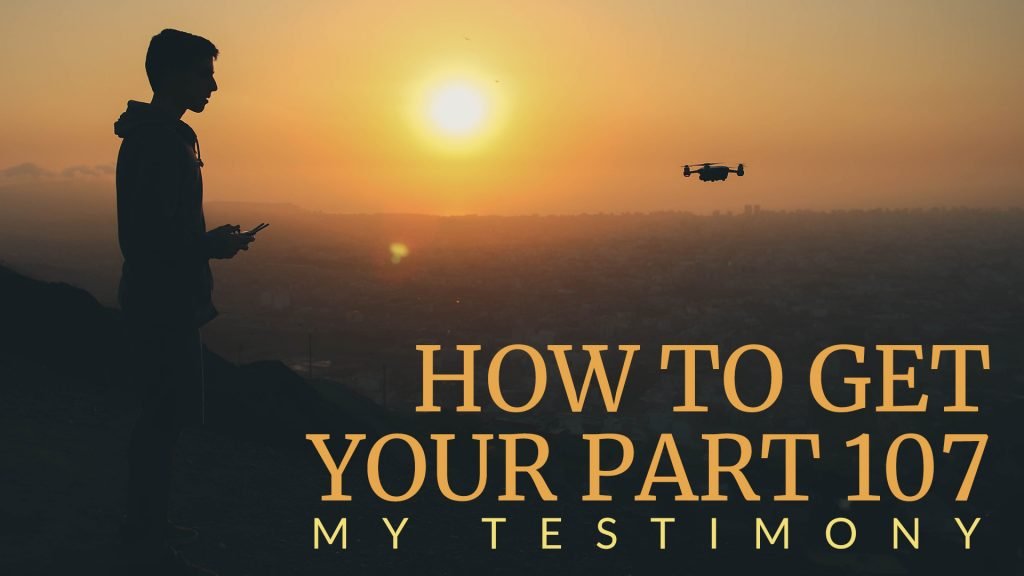
In this post, I want to share my experience of getting the Part 107 and offer a review of the Pilot Institute which I used to prepare for the exam. If you are considering getting a Part 107 and wondering where to start, I hope this post will help point you in the right direction.
I didn’t even know what Part 107 was when I started flying drones. But when I began participating in Jersey Droner events, I discovered that some of the members had this thing called Part 107. I wondered if it was something that I should consider getting. If you are wondering the same thing, I detailed 10 Reasons to Get a Part 107 License in another post.
When I finally decided to pursue a Part 107 License, I didn’t know what to do or where I needed to start. So I began searching Facebook, Google, and online forums to figure out what I needed to prepare. In this post, I will share:
- The Requirements
- Study Options
- My Experience with the Pilot Institute Course
- The Exam
- Applying for My License
Requirements
Part 107 is a strange name. It refers to a section of regulation from the FAA that governs the flight of unmanned aerial vehicles in the United States.
As I began my research, I learned that the one basic requirement was to pass an initial knowledge exam. I will talk more about the specifics of the exam in the exam section below. But know that the exam covers some basics in the world of aviation. The topics include:
- Regulations
- Airspace
- Weather
- Loading and performance
- Operations
- Night
A lot of that might not seem relevant to drones. But that is what you need to know. I knew I would need to do some studying to learn the required information about these topics.
Study Options
I was a bit overwhelmed when considering the many options to prepare for the exam. Below are listed some of the options I considered. These options ranged from books, apps, YouTube videos, online courses, and in-person courses.
1. Books & Apps
A quick search on Amazon brings up a couple book options.
I also found the Remote Pilot FAA Test Prep App. This is an app in the App Store that can be downloaded for iOS or Android.
2. YouTube Videos
You can find almost anything on YouTube. I have fixed cars, prepared meals, and solved computer issues by watching YouTube. Certainly, there must be videos on helping you pass the Part 107. And there are! Here are a few I came across:
YouTube is the cheapest option because it is free. And I believe that most people could pass the exam by watching a few YouTube videos.
But here is the problem with YouTube. The newest video I posted above is from 2018. It is three years old. And many regulations have changed since these videos were produced. So make sure that if you go the YouTube route, you know about updated regulations in regards to flying at night and flying over people.
The other issue that I found with watching YouTube videos was that they focus on passing the exam. But being a safe and responsible pilot is about more than simply passing a test. It is not just knowing the information but understanding the information.
3. Online Courses
I figured that if I wanted to do this, that I wanted to do it right. I didn’t want just to pass an exam but wanted to learn as much as I could to benefit my readers. So I decided that I would invest in an online course.
An online course is the most expensive option. That is why I said I would “invest” in an online course. The prices vary, but I found most between $149 and $199. The majority of the online courses guarantee that you will pass the test or your money back. If you complete a paid online course, it is virtually impossible to fail the test. Some online course options include:
- Pilot Institute
- UAV Ground School
- Drone Pilot Ground School
- Remote Pilot 101
- Drone Launch Academy
- Dronegenuity
Another option related to an online course would be in-person training. NJ Drone Academy offers both in-person and online courses. There may be in-person training in your community. A good starting place would be to inquire at your local community college.
In the end, I settled on Pilot Institute. I probably could have gone with any of the options. But I am happy with my choice. I scored 98% on my exam. I was confident going into the test. And I firmly understood the concepts behind the questions.
Please note that the link to Pilot Institute is an affiliate link. If you use this link to sign up for the course, I will receive compensation from Pilot Institute. I provide the affiliate link only because I give this online course my endorsement.
The Pilot Institute Course
The Pilot Institute is about more than drones. They offer courses for airplane pilots too. Maybe one day I will go for that!
There are also other drone courses besides the Part 107 course. Many of these courses are free. One example of a free course is the Mavic Air 2 Deep Dive. This is a course that goes through everything you need to know about this individual drone. Even if you don’t plan to get your Part 107, you might want to consider checking out some of these other courses.
Sign-Up
The Part 107 Made Easy Course lists for $249. But there is a discount code that takes $100 off. I have never seen the course not on sale for that price. If it is not discounted, you can likely find a discount code online.
The sign-up is easy. It is an online transaction. It is all very standard. You create an account, provide your credit card info, and hit submit. Once you sign up, you will get an email to confirm your account and provide you access to the course.
It was a bit overwhelming to open up the Pilot Institute course for the first time. There are 13 hours of video contained in 290 lectures. It seemed like an endless amount of scrolling to get to the bottom of the list of lectures. I wondered how long it would take me to get through it all.
Pilot Institute offers a 14-day challenge to help you efficiently get through the mountain of material. They encourage you to spend one hour a day for 14 days to finish the course. But I did not follow that approach.
My approach was to find little bits of time here and there. The individual lectures are usually 2-5 minutes long. I would find bits of time to watch a lecture or two throughout my day. For example, every Tuesday, I had a half-hour while I waited for my son at his drum lessons. I would be able to watch a good number of videos during this time.
How long did it take me to complete the course using my approach? I purchased the Pilot Institute Course on March 25, 2021. I passed my Part 107 exam on May 5, 2021. So it took me a little more than a month from start to finish.
Taking the Course
The Pilot Institute uses the Teachable platform to host this course. You could watch the videos using a browser on a computer. I found that Chrome worked better than Safari on my Mac. There was also an iPhone app that you can use. I made use of the app as much as the computer browser because the app was convenient when I was out and about.
There is a pdf handout that accompanies each section of the course. I downloaded these handouts to my iPad and imported them into Notability. Notability is a wonderful note-taking app that works well with the Apple Pencil.
Greg Reverdiau is the instructor for the course. The first thing you will notice is his French accent. But I must say it is pleasant to listen to. And that is a good thing considering the amount of time you will spend watching him. He is an aviation instructor and has extensive knowledge about both airplanes and drones. I would say that he is more than qualified to teach this course.
He is skilled as a teacher and was able to explain things in understandable terms. He made the presentation visual through graphs, charts, and 3d modeling. I did not have difficulty understanding anything that was taught in the course.
This course is in-depth. It contains more than you need to know to pass the exam. Greg explains what we need to know and why we need to know it (or at least why the FAA thinks we need to know it). There was nothing on the exam that was not covered in the course. And the extra things Greg goes through are all practical and good to know.
Other Course Benefits
Another benefit to this course is that it is regularly updated. Some lectures had been added, and others were updated to take into account the changing regulations. This is another advantage to a paid course over YouTube.
I appreciated the community that came with the course. The Pilot Institute has an active Facebook Group that students can join. I joined the group and participated in a few different discussions. It is also encouraging to hear other people’s testimonies on taking and passing the exam. Furthermore, each lecture in the course has a section available for comments and questions. There is often some good discussion on the subject matter in these threads.
The Pilot Institute has a Flash Card App. This app is available for anyone. But you are able to unlock additional cards when you are a student. This was another good study tool that I made frequent use of.
There are several quizzes throughout the course. The questions in these quizzes were similar to the questions that were on the FAA exam. Some of them were almost the same. You need to score a 70% on the FAA exam to pass. However, the Pilot Institute required you to score an 80% on their quizzes to move forward. This created a margin to ensure that you would actually get a 70% when it came time to take the FAA exam.
At the end of the course, there was a 60 question practice exam. The Pilot Institute gives you the go-ahead to schedule your FAA exam after you have passed the practice exam twice with a score of at least 80%. I scored a 95% both times I took the practice exam.
There are other online practice exams. But after scoring a 95% twice on the Pilot Institute exams, I did not feel it was necessary to take any more practice exams. Keep in mind that practice exams are not designed to help you learn the material but evaluate how well you have mastered the material. My scores indicated that I had learned enough.
The Exam
Scheduling the Exam
Scheduling the exam was not straightforward. The exam is administered by a group called PSI and not the FAA. PSI proctors the exams on behalf of the FAA. The only way to take the exam is at a PSI-designated site.
But before you can schedule your exam, you need to log into the Integrated Airman Certification and Rating Application website. The abbreviation is IACRA. You can find it at https://iacra.faa.gov and will need to create an account and get an “FTN” number to schedule your exam.
I know this might sound complicated. But the Pilot Institute has a lecture to walk you through this process.
Once you have your FTN number from IACRA, you can now go to the PSI site to schedule your exam. The first thing to do is to find a testing center nearby. You enter your zip code, search radius, and the exam you will be taking. When selecting the course, you will select the Unmanned Aircraft General (UAG) exam.
My search brought up PSI Service Centers, airports, and flight training centers around New Jersey. You should know that the price will vary depending upon the site you choose. The PSI Service Centers are the cheapest. It cost me $109 to schedule my exam at one of these sites. If you choose to schedule your exam at an airport or flight school, the cost is $173. That is a significant price difference. So if there is a PSI Service Center near you, make sure to schedule your exam there.
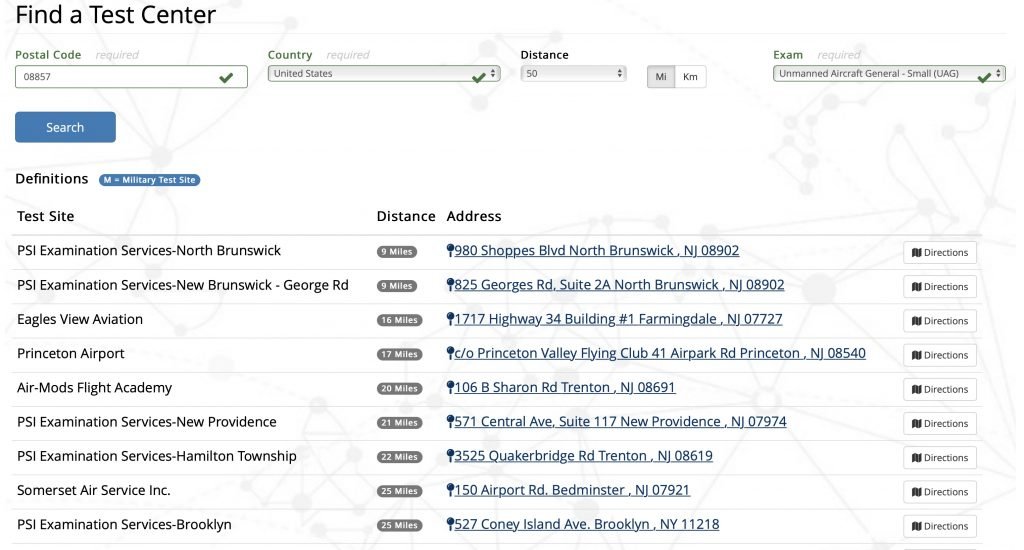
Once you know where you want to take the exam, you will create an account with PSI and schedule your exam. You will pay for your exam when you schedule it. There is no refund if you miss your scheduled time. You can reschedule, but you must reschedule more than 24 hours in advance. When I scheduled mine, there was availability the next day. But I scheduled my exam two days out.
Even though I was confident I would pass my test, I spent the next 48 hours reviewing my notes, rewatching selected lectures on the Pilot Institute site, testing myself with the flashcard app, and referencing a cheat sheet provided in the Pilot Institute.
Arriving at the Exam
On the day of the exam, I mapped out the directions to the testing center on Apple Maps. It estimated that I would take about 25 minutes to drive to the exam location. But to make sure to get there on time, I left an hour early. There are plenty of warnings when you sign up for your exam that if you are late that you might not get to take the exam and that you will forfeit your payment. I did not want to take any chances of missing my exam.
You are told to arrive 15 minutes before your scheduled exam to take care of paperwork and other check-in matters. My exam was scheduled for 9 am and I arrived at 8:25 am. So I spent about 20 minutes in my car reviewing course material before going in.
The exam center was located in a normal office building. The suite was on the second floor. As I made my way into the waiting room, four other people were waiting to take exams. But I am fairly certain that none of them were taking an FAA exam. One of the ladies had scrubs on. It seems that PSI administers all sorts of various exams.
We were all instructed to sit in chairs in the order that we arrived. And the proctor called us to her desk one by one. She carefully inspected each person to make sure they adhered to the guidelines of their exam.
You are told not to bring anything to the test except your driver’s license. They also allow you to bring a magnifying glass to help read the charts. I brought one but never used it.
The proctor asked me if I had any electronics. I realized I had my Apple Watch still on. So she asked me if I would take it off. She also asked if I had anything in my pockets. I had my keys and my driver’s license. She then gave me a key to put everything in a locker located in the waiting room.
She then provided me with two pencils, a piece of paper to use as a scratch pad, a calculator, and the testing supplement book. There are charts and information that the exam refers to in the testing supplement book. You can download a pdf of the book to review before the test.
Taking the Exam
Next, the proctor instructed me to walk into the exam room. There were maybe five other people taking exams. There were probably about a dozen workstations set up with dividers. I noticed a few cameras in the room to monitor those who were taking the exams.
The proctor went to my assigned workstation and logged in to the computer to start my exam. The computer was a standard PC and was not too fast. The initial screens asked me to verify my information and the exam I was taking. The next thing it did was have me take a practice test to make sure I knew how the testing system worked. The question in this initial exam were things like “who was the first President of the United States?” and “How many hours in a day?” Everything was super obvious.
Once you pass that 5 question exam and verify that everything is working properly, it is time to begin the real exam. When you hit the start button, you have two hours to answer 60 multiple-choice questions. There is more than enough time to complete the exam. I believe I completed the exam in about a half-hour.
I worked slowly through the test, making sure I read carefully and understood each question. Most of the questions I got wrong in practice exams had happened not because I did not know the answer but because I misread the question.
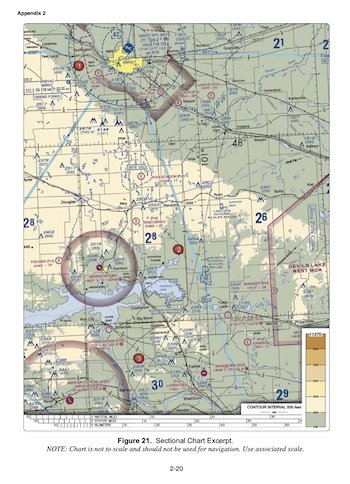
Many of the questions referred to charts in the testing supplement. So it is good to be familiar with the testing supplement before you take the exam. One thing that could be confusing is that the exam refers to figure numbers in the testing supplement. Each chart and diagram in the testing supplement had a figure number. But these are different than the page number. Don’t confuse the two!
Once you answered a question on the exam, there was a button to advance the screen to the next question. You also had to ability to go back to questions you had previously answered to change your answer. A bookmark feature allowed you to mark certain questions for review before submitting your exam.
I think there were three questions that I marked for review. I was confident that I could have hit submit and passed without reviewing the questions, but I went back to review those three questions to ensure I got the highest possible score I could. That is the way I am. Again, you need to score 70% on the test to pass. What that means is that you can miss 18 questions. And there were only three questions I doubted.
Finally, the moment of truth arrived. It was time to hit submit. I had done all I could do, and I could not do anymore. I submitted my final answers for the exam. It took a bit for it to go through. I waited and waited, thinking the results would appear on the screen. They never did. I got a message my test was over and to let the proctor know I was done.
I went back out into the waiting room. The first question the proctor asked me was if I made use of the magnifying glass. I told her no. She let me get my belongings out of the locker while she printed out my results. I would know momentarily.
She brought back a folded piece of paper. She opened it up and looked at it. Then said, “Congratulations, it’s the highest score I have ever seen.” I responded by telling her that I had a good instructor. She handed me the paper. I took a look, and it showed I had scored a 98%. I missed a perfect score by one question. It was only one question, but I would be lying if I did not say I was not disappointed.
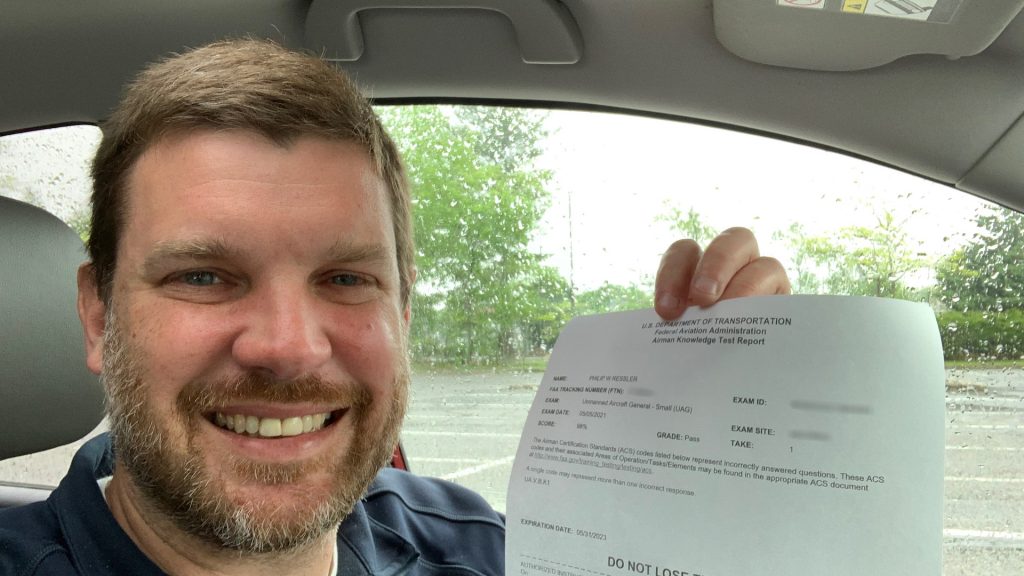
I had passed! All the preparation had paid off.
I made my way to the car and called my wife to tell her the good news. I had to show off a bit too. So I took a selfie in the car with my exam results and posted it on Facebook. I would have further celebrated by taking the drone flight, but it was pouring rain.
Applying for My License
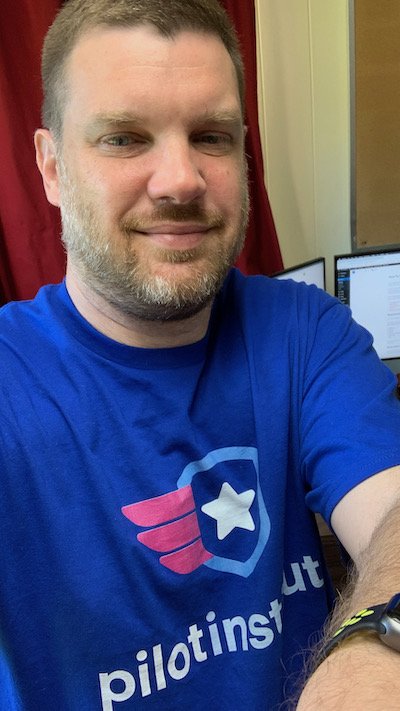
Now that I had passed the exam, all that was left to do was to submit my application for my Part 107 license. This is done by going back to the IACRA website and submitting your test results. Once that was done, you supply your name and address and submit. Again, The Pilot Institute has a video available to walk you through all this. There is no cost to apply for your license. The only cost in this process is the cost of the exam and any training courses or materials you might use. This whole process cost me $258. $149 for the course. And $109 for the exam.
I received an email four days after submitting my application that my temporary license was available to download. I was able to print it out and put it in my camera bag with my Air 2s. You must carry your licenses and registrations with you when you fly.
As of this writing, I am still waiting for my permanent license. It has been two weeks since I took the exam. I was told that it typically takes 4-6 weeks to receive your license. But I will make sure to update this post when it arrives.
The absolute last thing I had to do was to submit my score to Pilot Institute. They provide a free shirt to anyone who takes their course and scores 90%+ on the exam. I know that I will wear it with pride. It gives me a great sense of accomplishment to have completed this endeavor.
If you have any questions about the process to get your Part 107, don’t hesitate to ask. Just leave a comment in the comments section below or visit my contact page.

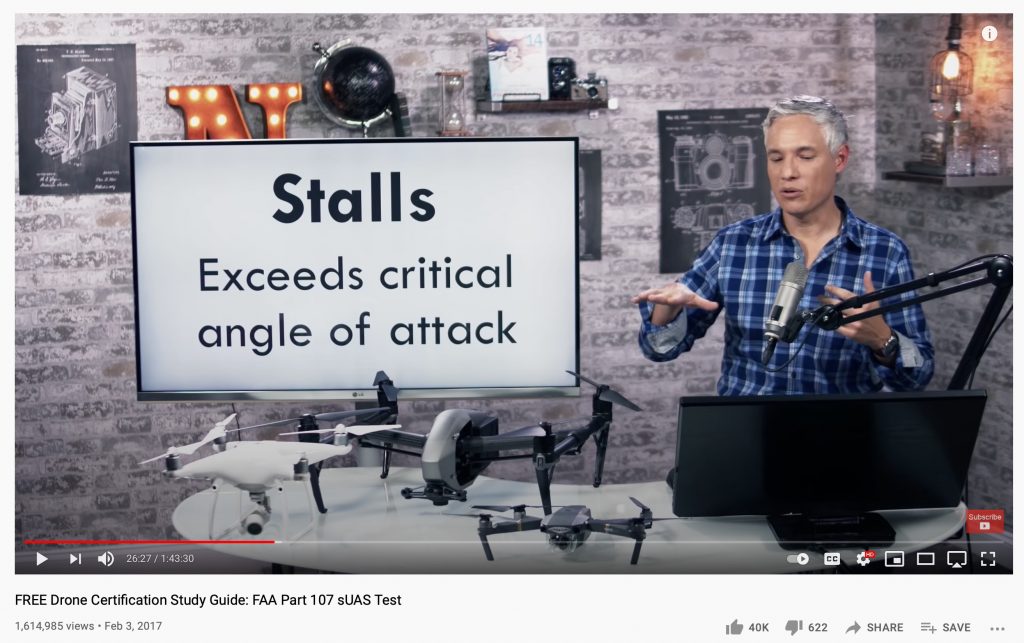
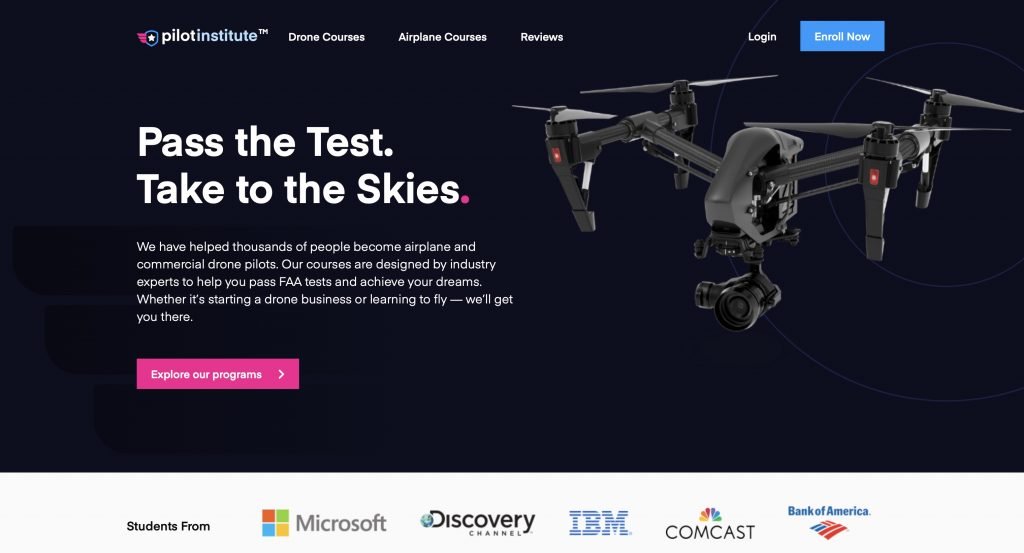
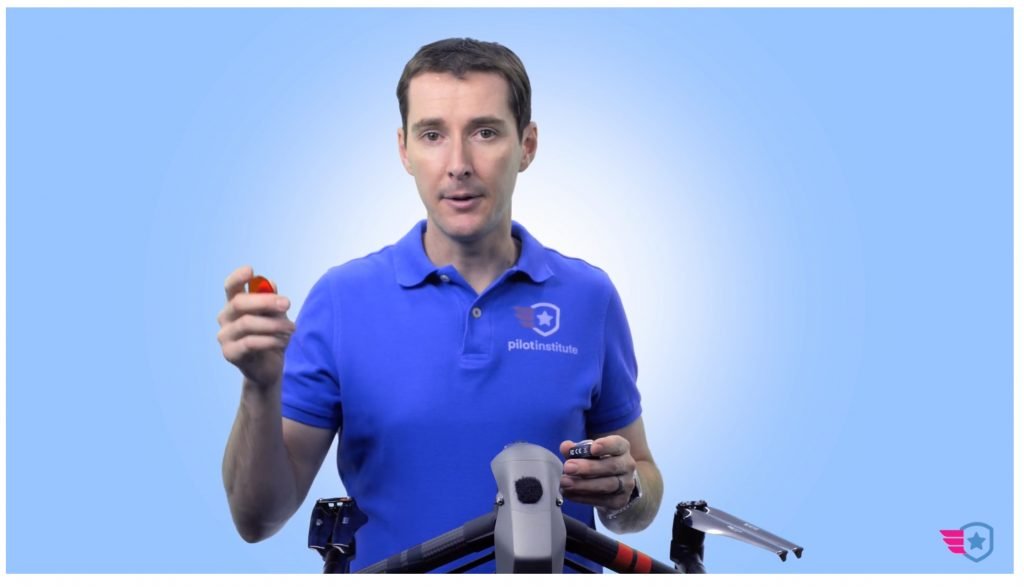
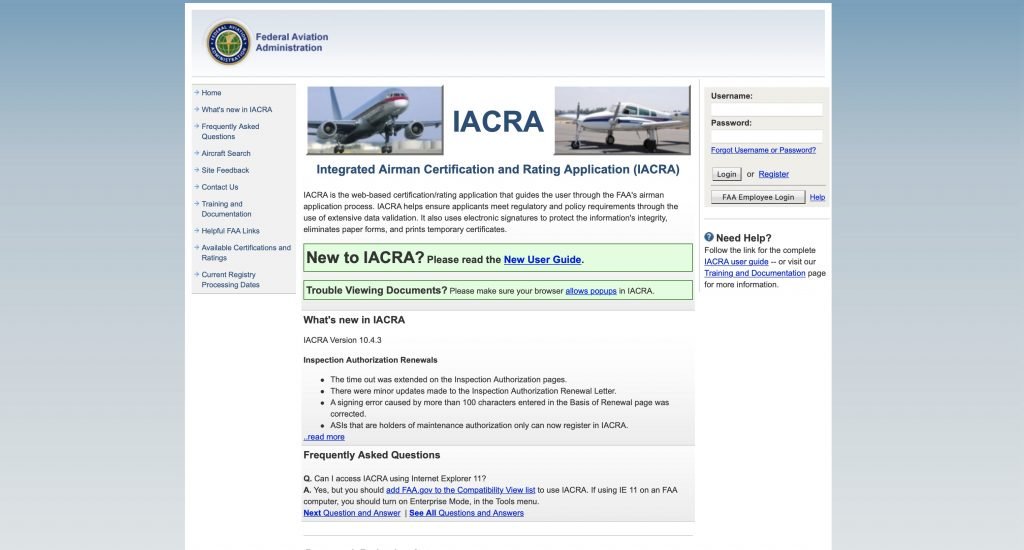
Leave a Reply